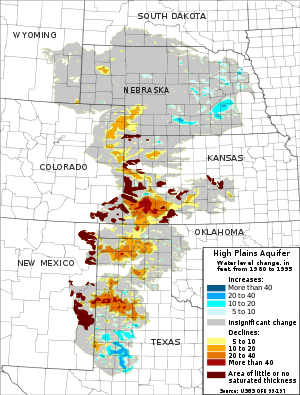After America’s Fossil Water Goes Dry, Will the Middle East Follow?
Published on by Water Network Research, Official research team of The Water Network in Academic
America's Fossil Water Goes Dry - Middle East is Next?
Ample fresh water supplies for agriculture and drinking by the world's burgeoning populationare becoming more and more scarace these days due to over-consumption and the ravages of global warming and climate change. This has resulted in the need to tap intoprehistoric underground aquifers, such as North Africa's Nubian Aquifer under Libya; and the the Disi and Wasia aquifers Jordan and Saudi Arabia.
Aquifers in other parts the world, containing large amounts ofancient or "fossil water", are also in jeopardy as these non-renewable sources of fresh water are being exploited by countries with increasing water needs.
One of America's largest "fossil water" aquifers is theOgallala aquifer, which lies under 8 states in America's "bread basket"wheat growing region; stretching from South Dakota to Texas.This aquifer coversa land area of 111.8 million acres (45.24 million Hectares) and 175,000 square miles (281,635 sq kilometers).
The water in this ancient aquifer is estimated to be at least 10 million years old and created during a period when there was considerably more water in that region; such as during the last great Ice Age. The water trapped in this aquifer in not replenished through annual rainfall; so once it is used up, it's gone - possibly forever.
Intensive farming in this region has resulted in large amounts of Ogallala water being tapped to grow grains such as wheat, corn and sorghum. These grains provide much needed foodstuffs and animal feeds for people living in the USas well as other parts of the world.
More recently, grains like corn and sorghum have also been used to manufacture biofuels like ethanol. The depletion of water in aquifers like the Ogallala is becoming a big concern to environmentalists who now estimate that most of the water remaining is this aquifer alone will be used up by the year 2028 in areas like Texas and Kansas. These states arenow in the midst of one of the worst droughts in recorded history.

If prehistoric aquifers like Ogallala are in danger of being depleted in non-desert regions, it doesn't take much imagination to figure out what will be fate of fossil water in desert aquifers like those under Jordan, Saudi Arabia and Libya.
When ex-Libyan leaderMuamar Gadaffi began his Great Man-Made River project in 1984, he boasted that the water in the Nubian Aquifer could supply the needs of Libya for "hundreds of years" and turn that country into an agricultural wonder. When the water was created there, animals like elephants, giraffes, wildebeests and other African species roamed that region and were hunted by primitive peoples.
The fossil water in Saudi Arabia's Disi (part of which is under Jordan) and Wasia aquifers may be even more ancient.
Jordan is now involved in a project toextract large amounts of Disi aquifer water and convey it to Ammanin large underground pipes. It's only a matter of time before this not replaceable water will be used up as well. There's no sure solution to the problems of severe water shortages, even with more strict water conservation and recycling of waste water supplies. This appears to be thereality facing many countries; especially those in water scarace regions like the Middle East.
Media
Taxonomy
- Habitat
- Desertification